
How to Use MAX7219 8x8 LED Matrix: Examples, Pinouts, and Specs
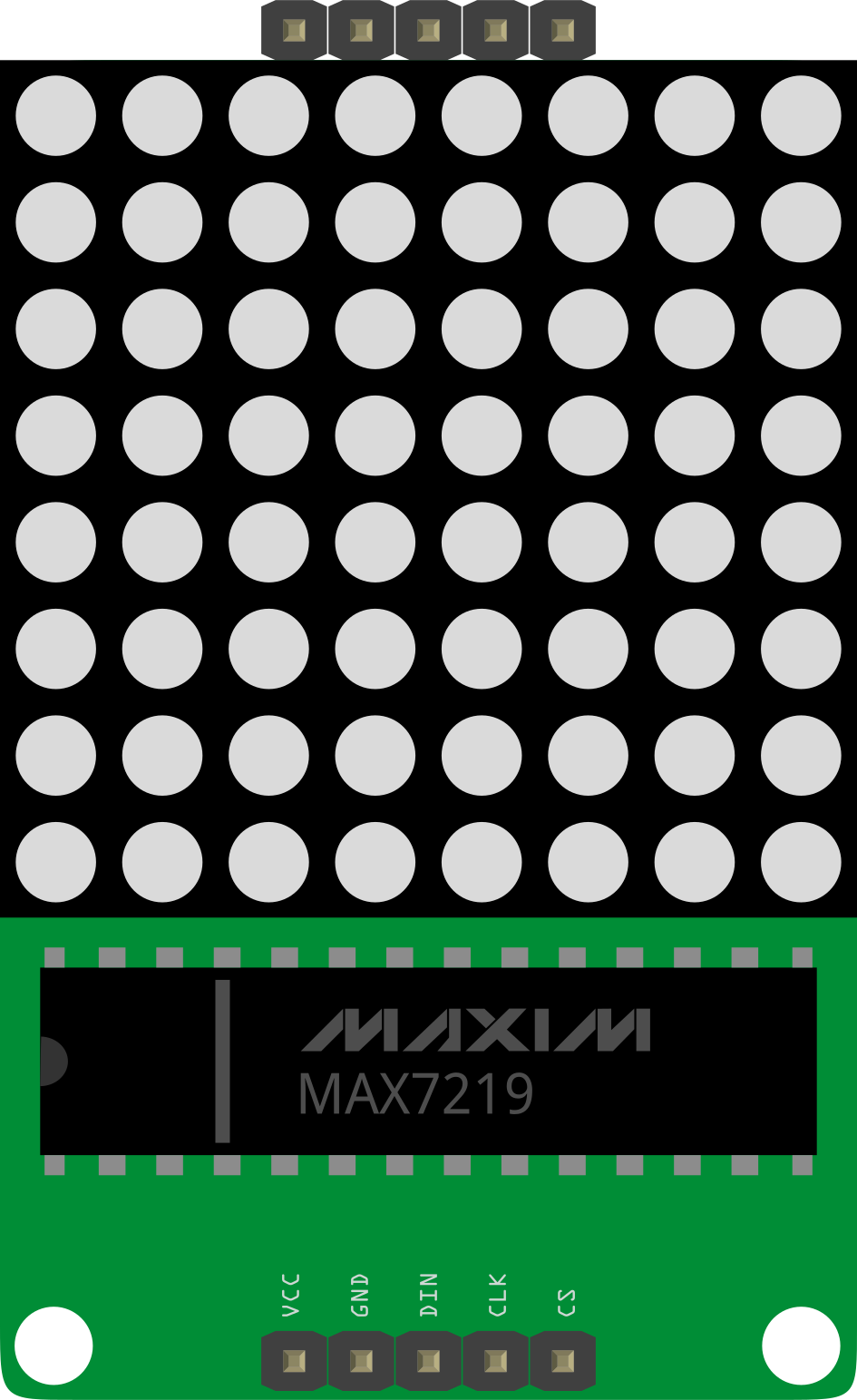
 Design with MAX7219 8x8 LED Matrix in Cirkit Designer
Design with MAX7219 8x8 LED Matrix in Cirkit DesignerIntroduction
The MAX7219 8x8 LED Matrix is a compact and versatile display driver designed to control up to 64 individual LEDs arranged in an 8x8 matrix. This component simplifies the process of driving multiple LEDs by using a serial interface, which significantly reduces the number of microcontroller pins required. It is commonly used in creating display panels for visual output, digital clocks, electronic games, and other devices that require a simple yet effective graphical display.
Explore Projects Built with MAX7219 8x8 LED Matrix
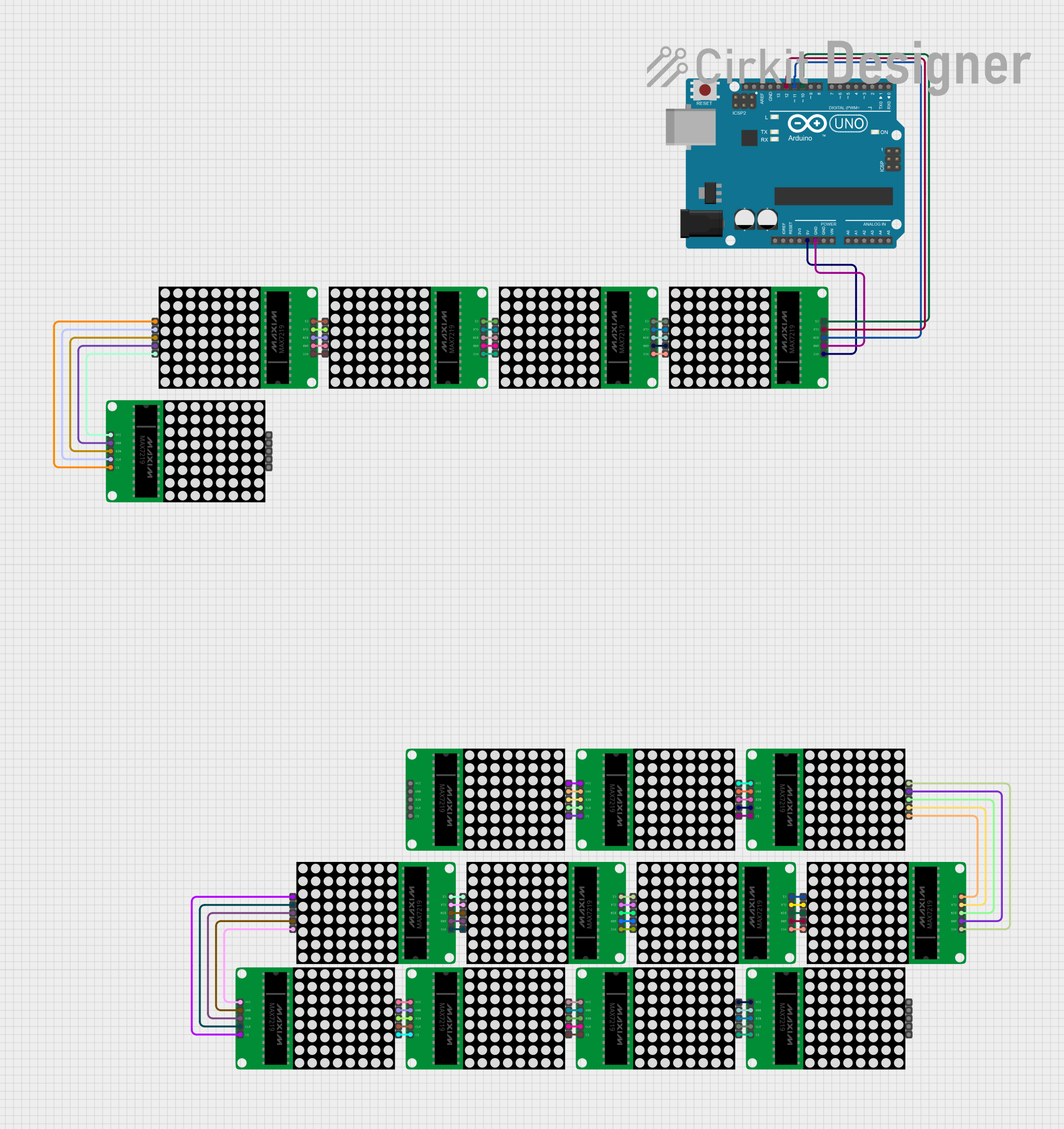
 Open Project in Cirkit Designer
Open Project in Cirkit Designer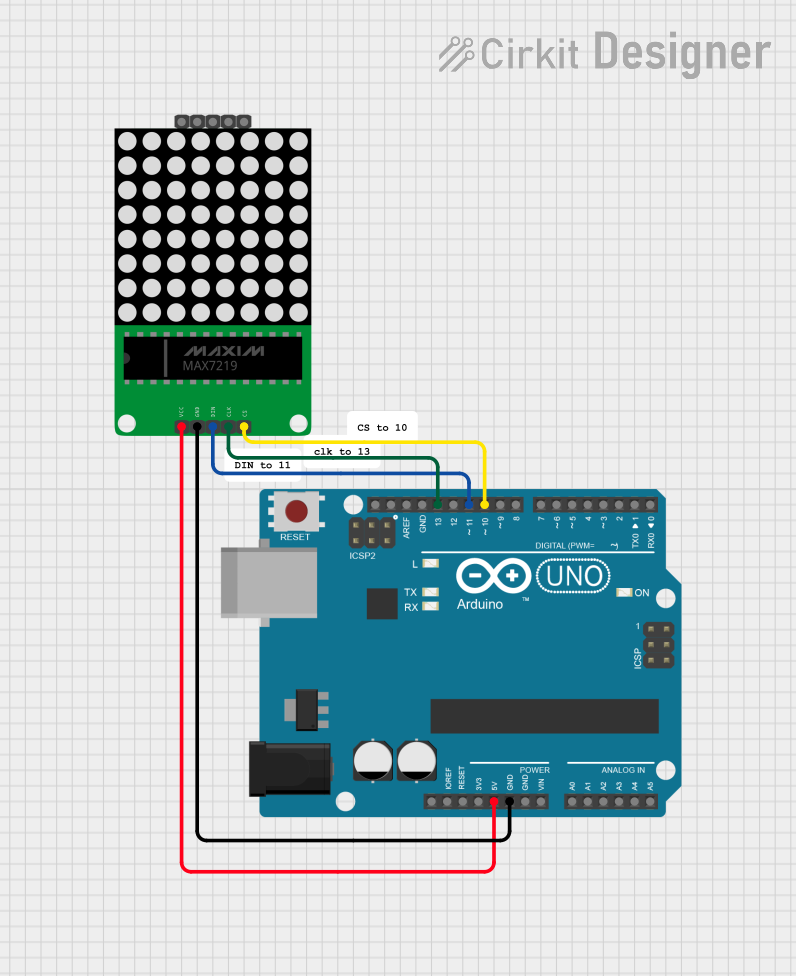
 Open Project in Cirkit Designer
Open Project in Cirkit Designer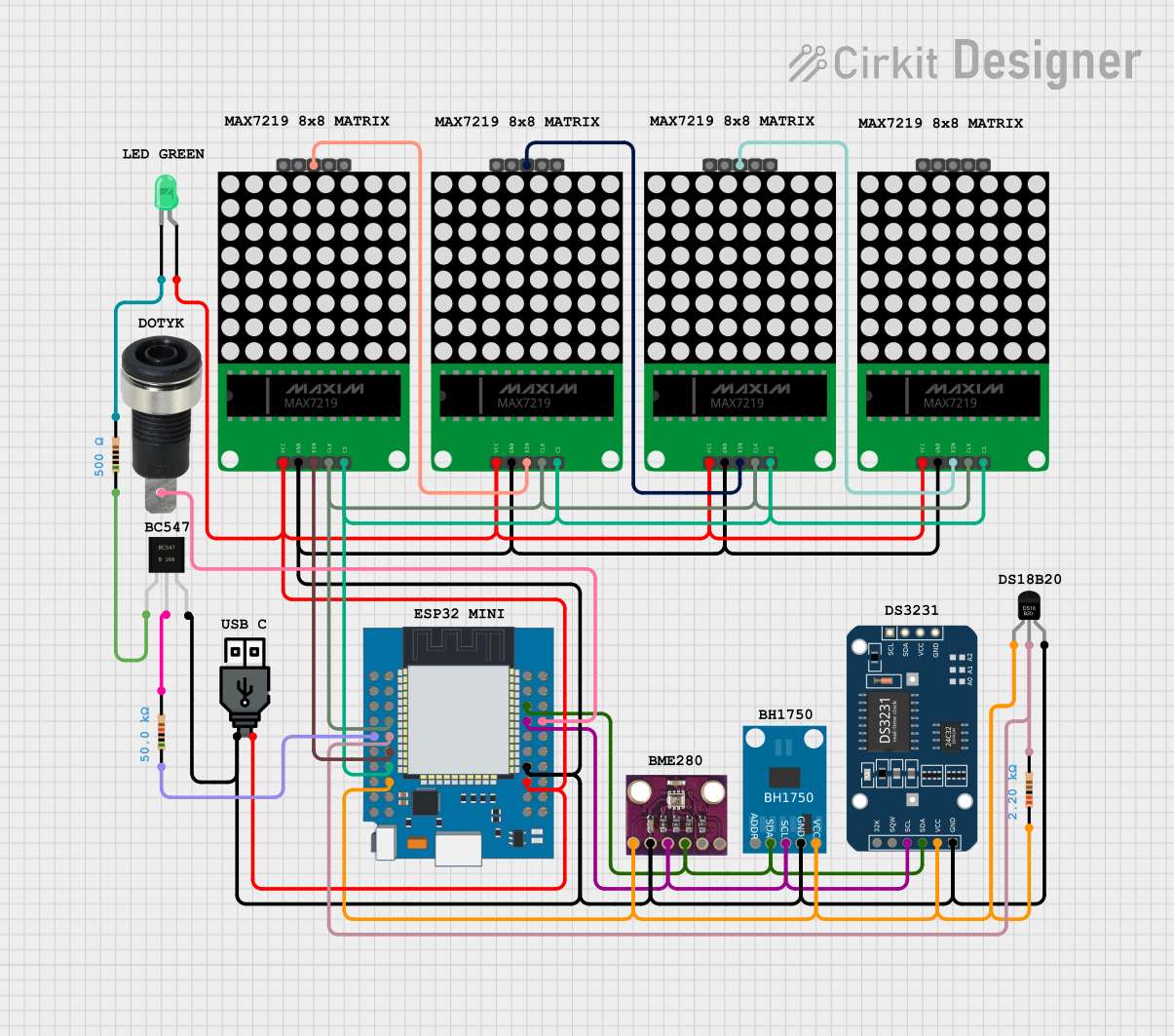
 Open Project in Cirkit Designer
Open Project in Cirkit Designer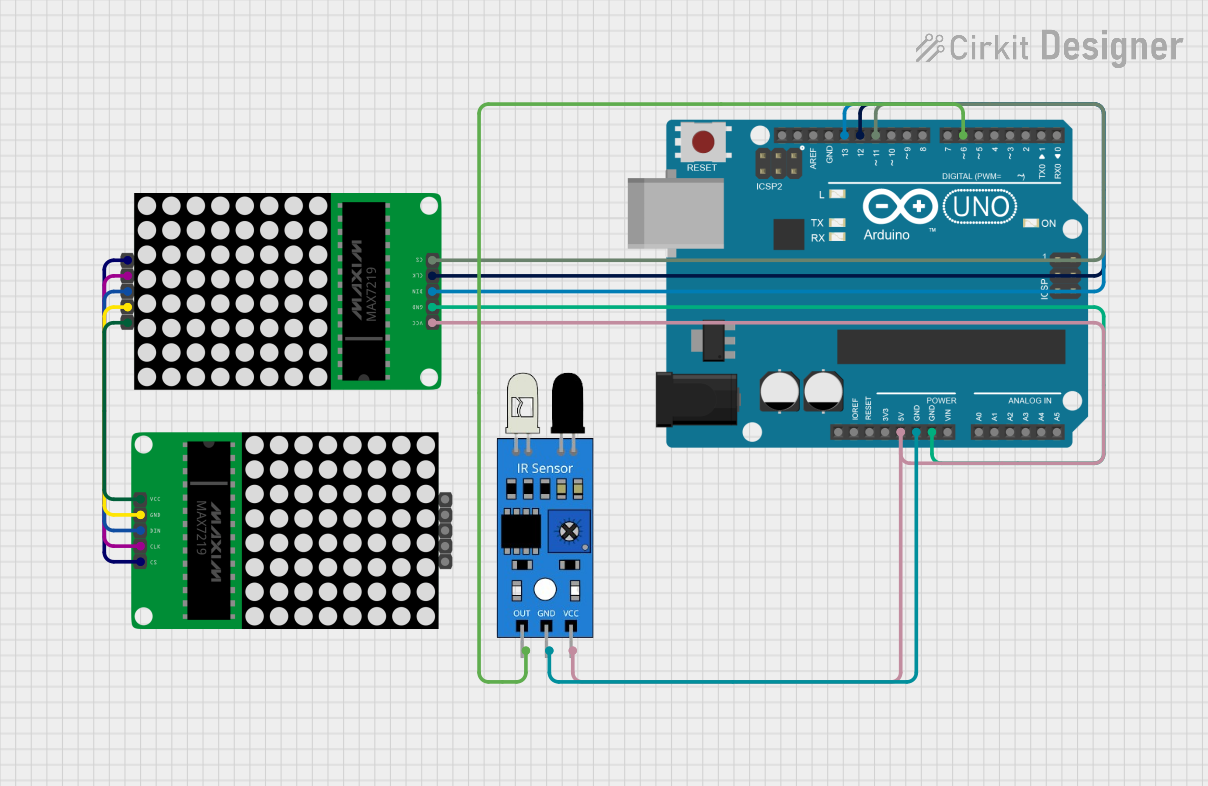
 Open Project in Cirkit Designer
Open Project in Cirkit DesignerExplore Projects Built with MAX7219 8x8 LED Matrix

 Open Project in Cirkit Designer
Open Project in Cirkit Designer
 Open Project in Cirkit Designer
Open Project in Cirkit Designer
 Open Project in Cirkit Designer
Open Project in Cirkit Designer
 Open Project in Cirkit Designer
Open Project in Cirkit DesignerCommon Applications and Use Cases
- Digital scoreboards
- Clock displays
- Message boards
- Gaming displays
- Interactive art installations
Technical Specifications
Key Technical Details
- Operating Voltage: 4.0V to 5.5V
- Maximum Current: 500mA (when all LEDs are on)
- Display Drive: Common cathode
- Interface: Serial (SPI-compatible)
Pin Configuration and Descriptions
| Pin Number | Name | Description |
|---|---|---|
| 1 | VCC | Power supply (4.0V to 5.5V) |
| 2 | GND | Ground |
| 3 | DIN | Serial-Data Input |
| 4 | CS | Chip Select (active low) |
| 5 | CLK | Serial-Clock Input |
| 6-13 | SEG A-G, DP | Segment and decimal point control for each digit |
| 14-21 | DIG 0-7 | Digit drive lines (common cathode) |
Usage Instructions
How to Use the Component in a Circuit
- Power Connections: Connect VCC to a 5V power supply and GND to the ground.
- Data Input: Connect the DIN, CS, and CLK pins to the microcontroller's SPI pins.
- LED Matrix: Connect the SEG and DIG pins to the corresponding pins on the 8x8 LED matrix.
Important Considerations and Best Practices
- Use a current-limiting resistor to prevent damage to the LEDs.
- Ensure that the power supply can handle the maximum current draw when all LEDs are on.
- Avoid long wires between the MAX7219 and the LED matrix to minimize signal degradation.
- Implement proper decoupling with a capacitor close to the VCC and GND pins of the MAX7219.
Example Code for Arduino UNO
#include <LedControl.h>
// Pin configuration for the MAX7219
int DIN_PIN = 2;
int CS_PIN = 3;
int CLK_PIN = 4;
// Create a new LedControl instance
LedControl lc = LedControl(DIN_PIN, CLK_PIN, CS_PIN, 1);
void setup() {
// Wake up the MAX7219 from power-saving mode
lc.shutdown(0, false);
// Set brightness level (0 is min, 15 is max)
lc.setIntensity(0, 8);
// Clear the display
lc.clearDisplay(0);
}
void loop() {
// Display a simple pattern on the LED matrix
for (int row = 0; row < 8; row++) {
for (int col = 0; col < 8; col++) {
lc.setLed(0, row, col, true); // Turn on LED at (row, col)
delay(200);
lc.setLed(0, row, col, false); // Turn off LED at (row, col)
}
}
}
Troubleshooting and FAQs
Common Issues
- All LEDs are dim or flickering: Check the power supply and ensure it can provide sufficient current.
- Some LEDs are not lighting up: Verify the wiring between the MAX7219 and the LED matrix, and check for any damaged LEDs.
- Garbled or incorrect display: Ensure that the SPI communication is functioning correctly and that there are no loose connections.
Solutions and Tips for Troubleshooting
- Double-check all connections, especially the DIN, CS, and CLK lines.
- Use a multimeter to verify that the correct voltage is present at the VCC pin.
- Replace the LED matrix if you suspect it has damaged LEDs.
- Ensure that the microcontroller's SPI settings match the requirements of the MAX7219.
FAQs
Q: Can I daisy-chain multiple MAX7219 modules? A: Yes, the MAX7219 is designed to be daisy-chained. Connect the DOUT of the first module to the DIN of the next, and so on.
Q: How do I control the brightness of the LEDs?
A: Use the setIntensity() function in the LedControl library to adjust the brightness level.
Q: What is the maximum number of devices I can control with a single microcontroller? A: Theoretically, you can control as many devices as the microcontroller's memory can handle, but practical limits are set by the power supply and signal integrity over long daisy chains.